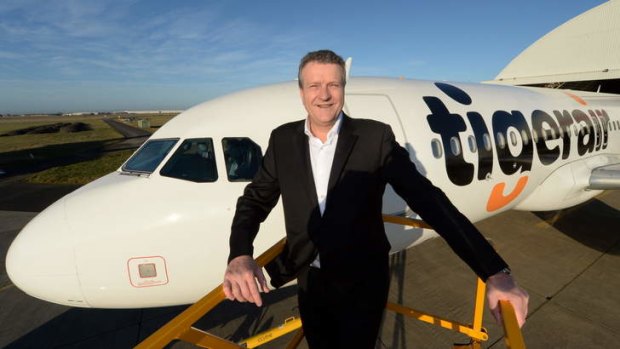This was published 10 years ago
Being No.1 on price crucial in big Tiger ramp-up

On the up? Tiger Airways CEO Rob Sharp.
So Tiger Airways has had a paint job and a minor name change. Woo hoo. The real story is that the Australia's airline price leader – the carrier that's usually the cheapest on the routes it contests because it has the industry's lowest unit costs – has committed to doubling in size in the next five years.
The newly minted Tigerair brand has had a "refresh" to try to put some space between it and the old management that shook consumer confidence in its ability to deliver people safely to their destinations after the 2011 grounding by the Australian Civil Aviation Safety Authority for serious safety breaches.
Tiger Australia is also in the process of transferring 60 per cent of its ownership from its Singapore interests (dominated by Singapore Airlines) to Virgin Australia, which presents opportunities to ride on the coat-tails of its bigger sister in some back office functions that will increase efficiencies and, crucially, reduce costs.
But Tiger's new Australian boss is wary of falling into the same traps as those that befell low-cost carrier Virgin Blue, even before it became almost-full-service carrier Virgin Australia.
Under founder Brett Godfrey, in the vacuum left by the collapse of Qantas's only full-service competitor, Ansett, Virgin Blue began accumulating extra operating costs – for in-flight live TV, valet parking, a frequent flyer scheme and other full-service trimmings – that left it as a low-cost carrier in name only before its latest transformation under new boss John Borghetti.
Even Jetstar has become a relatively high-cost low-cost carrier because of the demands of the Qantas parent to provide connectivity for the parent's customers on routes that Qantas doesn't fly.
Tiger Australia still has to turn its first annual profit from its Australian operations.
"One of the reasons that Tiger will remain independent of Virgin is that we don't want to see cost "creep" and that it does retain its low-cost mantra," says Tiger Australia's new chief executive Rob Sharp.
That means Tiger won't behave like an extension of the Virgin Australia parent on routes that Virgin doesn't fly – for example, there will be no Virgin Velocity priviledges or points-earning on Tigerair.
Crucially, however, that means Tiger retains its low costs – around five cents per available seat kilometre network-wide, compared to around eight cents per ASK on rival Jetstar.
Crudely, that means that when Tiger advertises a $39 special (plus the $8.50 per sector "booking fee" – a sleight-of-hand price-gouge that's virtually compulsory; this is actually the hated credit card fee that all airlines are still charging, despite a consumer outcry) on a typical interstate trip like Melbourne-Sydney, it's actually not losing money, though it depends on punters taking up other "optional" extras to make the exercise worthwhile.
That's the Tiger advantage from a business point of view. But it still needs more "critical mass" – business speak for "size" – if it is to guarantee profitability and a long-term future.
Tiger Australia still has to turn its first annual profit from its Australian operations. It got to close to break-even around 2010, but the 2011 grounding and subsequent operating restrictions have seen losses soar to an annualised $60 million.
Sharp, a former Qantas executive who's been in the Tiger job for only two months, does have one advantage: a staff of 350 people that's highly motivated after the airline's near-death in 2011.
"I've probably met 100 of the crew," says Sharp. "They're very highly motivated. They're typically young and energetic."
His next task is to try to translate that enthusiasm into an airline that's "warm, passionate and genuine", as Sharp said at last Wednesday's rollout of the first A320 jet painted in Tigerair's new livery.
"The airline recognises it's not just as simple as saying this," Sharp says. "The team needs to live and breathe it day in and day out.
"If you look back at it, the airline was stuck in a holding pattern for about six months and I think that staff were quite concerned. And so having the investment from Virgin has really reinvigorated the business.
"What we need to do, though, is be much clearer about who we actually are and empowering the staff a bit more as well. It's certainly a journey.
"You don't just put up a new logo and the staff are suddenly across this. It's something that we're going to have to develop and reinforce over a period of time."
Are you a regular Tiger user? Have you ever used Tiger? Do you like the new branding and will it make a difference? What does Tiger need to do to get your business?
FOOTNOTE: Tiger Airways Holdings Limited (Tigerair) and Virgin Australia Holdings Limited (Virgin Australia) today announced they had "completed the transaction announced on 30 October 2012, with Virgin Australia acquiring 60 per cent of Tiger Airways Australia Pty Ltd (Tigerair Australia)".
Sign up for the Traveller Deals newsletter
Get exclusive travel deals delivered straight to your inbox. Sign up now.